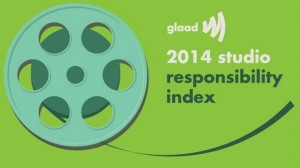 The Gay and Lesbian Alliance Against Defamation (GLAAD) released their second annual Studio Responsibility Index and found a wholesale rejection of fleshed-out, complex representations of the LGBT community in film. Again. In a press release today, the gay rights organization sharply noted, “Despite consistent conservative labeling of Hollywood as a liberal propaganda machine, GLAAD found that LGBT representations in contemporary Hollywood films tend to be far more scarce and regressive than those on television. Sadly, little changed in the following year. Out of the 102 releases GLAAD counted from the major studios in 2013, 17 of them (16.7%) contained characters or impressions identified as either lesbian, gay, bisexual, or transgender. In most cases, these characters received only minutes – or even seconds – of screen time, and were often offensive portrayals.”
The Gay and Lesbian Alliance Against Defamation (GLAAD) released their second annual Studio Responsibility Index and found a wholesale rejection of fleshed-out, complex representations of the LGBT community in film. Again. In a press release today, the gay rights organization sharply noted, “Despite consistent conservative labeling of Hollywood as a liberal propaganda machine, GLAAD found that LGBT representations in contemporary Hollywood films tend to be far more scarce and regressive than those on television. Sadly, little changed in the following year. Out of the 102 releases GLAAD counted from the major studios in 2013, 17 of them (16.7%) contained characters or impressions identified as either lesbian, gay, bisexual, or transgender. In most cases, these characters received only minutes – or even seconds – of screen time, and were often offensive portrayals.”
As GLAAD points out, Hollywood is still one of America’s greatest cultural exports. It has the power and financial prowess to leave an indelible mark on other country’s attitudes toward the LGBT community. And in a world that has seen a dismal turn of events these last two years in places like Russia, Southeast Asia and Africa, Hollywood has failed to seize the moment in helping shape these attitudes. “In countries like Russia or Uganda, recent discriminatory laws based on misinformation, dangerous stereotypes, and old-world prejudice are making it increasingly difficult for LGBT people to live free and happy lives. Hollywood has the chance to encourage greater understanding with the films they export, but at the very least, they must stop producing representations that could validate misconceptions and fears about LGBT people. Anything less is dangerously irresponsible.”
Of course, given the proliferation of healthy depictions of the LGBT community on television and cable, the question is why?
According to the report, it’s a tussle between what Hollywood execs argue is a dearth of scripts featuring LGBT characters and scriptwriters who counter that there are plenty of scripts. What’s missing, they say, is a willingness to portray those characters on the big screen. “In response to last year’s unfortunate findings, the most common question we heard was ‘Why does mainstream film seem to be so far behind the times?'” Through meetings with film professionals following the release of the Studio Responsibility Index, we got the chance to directly ask the question. From Hollywood executives, we repeatedly heard “We’re not getting scripts with LGBT characters,” while screenwriters told us, “The studios don’t want to make films with LGBT characters.” The truth is probably somewhere between these two accusations, but if one thing is certain, it’s that nothing will change until there are significant cultural shifts within the industry itself.
The report also touches on the state of television where, anyone can tell you, gay and lesbians characters are frequently shown, not as campy sidekicks to the perpetually single, but lovable, single female lead or as nesting, prudish and schoolmarm-y old widows, but as endearing, heartfelt characters who we actually care about. “Change certainly doesn’t come easy to some Hollywood studios who have long relied on mass-appeal products, but TV has demonstrated that mainstream audiences will fully embrace LGBT characters and stories. Yes, some of the most groundbreaking shows in recent years have been inclusive, but so have some of the safest bets. You don’t need to look any further than Modern Family as evidence; a warm-hearted, intergenerational family comedy series that prominently features a gay couple with an adopted daughter. And for five years, it’s been a hit with liberal and conservative audiences alike, demonstrating that American viewers are much more accepting and forward thinking than they are often given credit for.”
Whether or not Hollywood changes its attitude toward its depiction of the LGBT community remains to be seen. But with television and cable continuing to produce outstanding and diverse fare and Hollywood churning out tired and predictable schlock, the answer seems increasingly obvious with each successive Hollywood flop.











